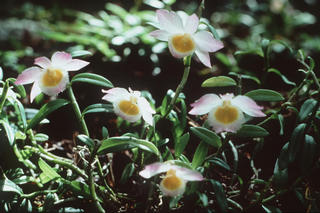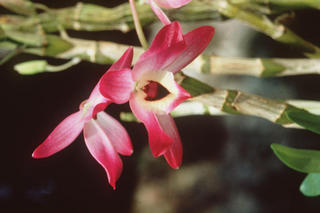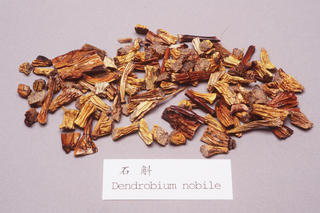Dendrobium loddigesii
Contents
Nomenclature
Other Names:
Historical Use of Dendrobium loddigesii
Dendrobium loddigesii in Traditional Chinese Medicine
Background
Chuangshihu ´¨Ê¯õú
Huoshihu »ôʯõú
Jinshihu ½ðʯõú
Xianshihu ÏÊʯõú
Chinese Name (pinyin): Shihu
Chinese Name :
Common Name :Dendrobium
Specific Name : Herba dendrobii
Scientific Name:
Collection : he drug is collected in all year round, fresh material removed from root and soil, dry material removed from foreign matter treated with boiling water for a moment or baked gently to often the rub whle baking or sun drying to remove the leaf sheaths and dried, some rootlets of Dendrobium candidum are trimmed off, stir fried while twisting to a spiral or spring form, then baked to dryness and known as Erhuanshihu (earing-like dendrobium)
Description : Fresh Dendrobium: cylindrical or flattened cylindrical, about 30cm long, 0.4 - 1.2cm in diameter. Externally yellowish green, smooth or striated longitudinally with distinct nodes, deeper coloured, bearing membranous leaf sheaths. Fleshly succulent, easily broken, odour slight, taste slightly bitter then sweetish and viscous and chewed.Herb of Dendrobium Ioddigesii: Slenderly cylindrical, frequently curved, rolled into masses, 15 - 35cm long, 1 - 3 mm in diameter, internodes 1 - 2cm long. Externally golden, lustrous, finely striated longitudinally. Texture pliable and solid, fracture relatively even. Odourless, taste weak.Herb of Dendrobium fimbriatum: Long conical, 40 - 120cm long, 5 - 8mm in diameter, internodes 3 - 4.5cm long. Externally yellow to dark yellow, deeply grooved longitudinally. Texture lax, fracture fibrous, taste slightly bitter.Herb of Dendrobium Chrysanthum: 30 - 80cm long, 3 - 5mm in diameter, intenodes 2 - 3.5cm long. Externally golden to yellowish-brown, furrowed longitudinally. Texture light and solid, easily broken, fracture somewhat fibrous, viscous when chewed.Erhuanshihu (ear-like Dendrobium): spiral or spring like, usually with 2 - 4 spires, 3.5 - 8cm long when stem pulled to be straight, 2 - 3mm in diameter. Externally yellowish green, finely wrinkled longitudinally at one end. Some short fibrous roots remained at the base of the stem. Texture compact, easily broken, fracture even, viscous when chewed.Herb of Dendrobium nobile: Flattened cylindrical, 20 - 40cm long, 4 - 6mm in diameter, internodes 2.5 - 3cm long. Externally golden yellow or greenish yellow, deeply furrowed longitudinally. Texture hard and fragile, fracture relatively even, taste bitter.
Identification :
Processing : Dry materials, removed from remains of roots, wash clean, cut into sections and dry.
Action : To benefit the stomach, to promote the production of body fluid, to mourish yin, to remove heat.
Indication : thirst due to impairment of yin or deficiency of body fluid; loss of appetite with nausea; fever in deficiency conditions after a severe disease; impaired vision
Precautions :
Dosage : 6 to 12 g; or 15 to 30 g of the fresh herb.
Storage : Preserve in a ventilated dry place, protected from moisture; keep the fresh material in a cool and dry place, protected from freezing.
Synonymns for Dendrobium loddigesii
Patent Medicines and Medicines with Multiple Ingredients that include Dendrobium loddigesii
Pharmaceutical Information
Chemical Constituents
Evidence or the Use of Dendrobium loddigesii in the Treatment of Epilepesy
Basic Science
Animal Studies
Cohort, Case-Control and Non-Randomized Trials
Randomized Controlled Trials
Meta-Analysis
1st Five Results: pubmed search
Aizhen Hu, Qingwang Liu, Jing Ouyang
Identification and characterization of the metabolites of moscatilin in mouse, rat, dog, monkey and human hepatocytes by LC-Orbitrap-MS/MS combined with diagnostic fragment ions and accurate mass measurements.
Biomed Chromatogr: 2023, 37(4);e5573
[PubMed:36529812]
[WorldCat.org]
[DOI]
(I p)
Yuanjun Meng, Zhiyun Liang, Lin Zhang, Li Hu, Jingran Fu, Gang Wei, Yuechun Huang
Identification of three types of O-glycosylated flavonoids in Dendrobium loddigesii, Dendrobium primulinum, Dendrobium crepidatum, Dendrobium porphyrochilum, and Dendrobium hancockii using mass spectrometry.
Rapid Commun Mass Spectrom: 2023, 37(2);e9421
[PubMed:36279199]
[WorldCat.org]
[DOI]
(I p)
Jiawei Ling, Chung-Lap Chan, Chi-Yan Ho, Xun Gao, Sin-Man Tsang, Ping-Chung Leung, Jiang-Miao Hu, Chun-Kwok Wong
The Extracts of Dendrobium Alleviate Dry Eye Disease in Rat Model by Regulating Aquaporin Expression and MAPKs/NF-κB Signalling.
Int J Mol Sci: 2022, 23(19);
[PubMed:36232498]
[WorldCat.org]
[DOI]
(I e)
Chunxing Pan, Surui Chen, Ziming Chen, Yiming Li, Yike Liu, Zejun Zhang, Yani Xu, Guanting Liu, Kaiye Yang, Guangrong Liu, Zhiyun Du, Lanyue Zhang
Assessing the geographical distribution of 76 Dendrobium species and impacts of climate change on their potential suitable distribution area in China.
Environ Sci Pollut Res Int: 2022, 29(14);20571-20592
[PubMed:34741266]
[WorldCat.org]
[DOI]
(I p)
Yue-Hu Wang
Traditional Uses and Pharmacologically Active Constituents of Dendrobium Plants for Dermatological Disorders: A Review.
Nat Prod Bioprospect: 2021, 11(5);465-487
[PubMed:33880726]
[WorldCat.org]
[DOI]
(P p)


